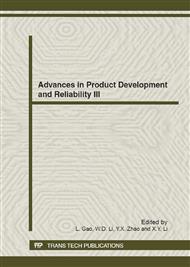p.110
p.115
p.121
p.130
p.139
p.145
p.151
p.159
p.164
Strength Optimization Design of a Helical Hydraulic Rotary Actuator
Abstract:
A helical hydraulic rotary actuator for part-turn motion control is presented. Because of its compact structure and large output torque, strength study for the helical hydraulic rotary actuator becomes very necessary. Using AWE, influences of multi-start thread engagement length, thread start number, spline pressure angle and piston material on strength of the actuator’s key parts are studied in depth, so as to optimize the actuator’s strength and structure. The results show that the influences of nut width, thread start number and piston material on multi-start thread root strength of nut are notable, the influence of pressure angle on spline tooth root strength of output shaft is visible, and stress concentration on multi-start thread root and spline tooth root is very obvious.
Info:
Periodical:
Pages:
139-144
Citation:
Online since:
June 2012
Authors:
Price:
Сopyright:
© 2012 Trans Tech Publications Ltd. All Rights Reserved
Share:
Citation:


